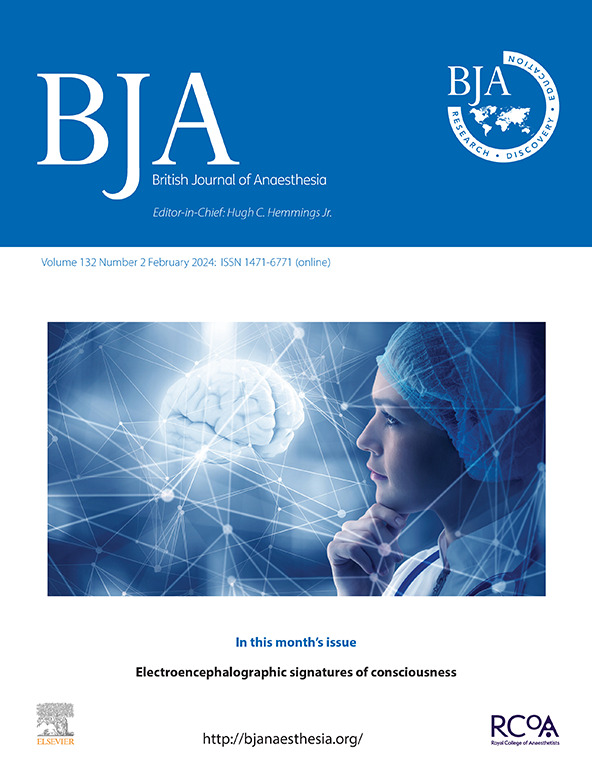Erector spinae plane block versus paravertebral block for major oncological breast surgery: a multicentre randomised controlled trial.
IF 9.1
1区 医学
Q1 ANESTHESIOLOGY
引用次数: 0
Abstract
BACKGROUND Breast cancer is the most common cancer in women, and oncological breast surgery often results in significant postoperative pain. Regional analgesia techniques such as thoracic paravertebral block (PVB) are effective but carry risks, whereas the erector spinae plane block (ESPB) is a newer, potentially safer alternative. We compared the efficacy of ESPB and PVB for managing acute pain after major breast cancer surgery. METHODS This prospective, multicentre, randomised, double-blind trial involved 292 women who underwent major breast surgery. Patients were randomised to receive either ESPB or PVB. The primary outcome was the percentage of participants requiring morphine within the first 2 h after surgery, and the secondary outcomes included pain scores, morphine consumption, complications, and participants satisfaction. RESULTS A total of 75.2% and 50.3% of the participants in the ESPB and PVB groups, respectively, required morphine, and the noninferiority criterion for ESPB was not met. However, morphine consumption was similar between the groups. Pain scores were greater in the ESPB group, especially during mobilisation, and ESPB provided less reliable dermatomal coverage than PVB, with the required area was not covered in 55.9% of participants in the ESPB group compared with 20.4% of participants in the PVB group. Satisfaction was similar between groups, with participants in both groups reporting high satisfaction. No major complications were observed. CONCLUSIONS Compared with thoracic paravertebral block, erector spinae plane block did not meet the noninferiority criteria and was less effective for complete analgesia. Thoracic paravertebral block remains the preferred technique for major breast surgery. CLINICAL TRIAL REGISTRATION ClinicalTrials.gov (NCT04827030).竖脊肌平面阻滞与椎旁阻滞用于重大肿瘤乳房手术:一项多中心随机对照试验。
背景:乳腺癌是女性中最常见的癌症,乳房肿瘤手术通常导致明显的术后疼痛。局部镇痛技术如胸椎旁阻滞(PVB)是有效的,但存在风险,而竖脊肌平面阻滞(ESPB)是一种较新的、可能更安全的替代方法。我们比较了ESPB和PVB治疗乳腺癌大手术后急性疼痛的疗效。方法:这项前瞻性、多中心、随机、双盲试验纳入了292名接受乳房大手术的女性。患者随机接受ESPB或PVB治疗。主要结局是术后2小时内需要吗啡的参与者的百分比,次要结局包括疼痛评分、吗啡消耗、并发症和参与者满意度。结果ESPB组和PVB组分别有75.2%和50.3%的受试者需要吗啡,未达到ESPB的非劣效性标准。然而,吗啡的摄入量在两组之间是相似的。ESPB组的疼痛评分更高,特别是在活动期间,ESPB提供的皮肤覆盖比PVB更不可靠,55.9%的ESPB组参与者没有覆盖所需的区域,而PVB组的这一比例为20.4%。两组之间的满意度相似,两组的参与者都报告了很高的满意度。无重大并发症。结论与胸椎旁阻滞相比,竖脊肌平面阻滞不符合非劣效性标准,对完全镇痛效果较差。胸椎旁阻滞仍然是大乳房手术的首选技术。临床试验注册网站clinicaltrials .gov (NCT04827030)。
本文章由计算机程序翻译,如有差异,请以英文原文为准。
求助全文
约1分钟内获得全文
求助全文
来源期刊
CiteScore
13.50
自引率
7.10%
发文量
488
审稿时长
27 days
期刊介绍:
The British Journal of Anaesthesia (BJA) is a prestigious publication that covers a wide range of topics in anaesthesia, critical care medicine, pain medicine, and perioperative medicine. It aims to disseminate high-impact original research, spanning fundamental, translational, and clinical sciences, as well as clinical practice, technology, education, and training. Additionally, the journal features review articles, notable case reports, correspondence, and special articles that appeal to a broader audience.
The BJA is proudly associated with The Royal College of Anaesthetists, The College of Anaesthesiologists of Ireland, and The Hong Kong College of Anaesthesiologists. This partnership provides members of these esteemed institutions with access to not only the BJA but also its sister publication, BJA Education. It is essential to note that both journals maintain their editorial independence.
Overall, the BJA offers a diverse and comprehensive platform for anaesthetists, critical care physicians, pain specialists, and perioperative medicine practitioners to contribute and stay updated with the latest advancements in their respective fields.

 求助内容:
求助内容: 应助结果提醒方式:
应助结果提醒方式:


